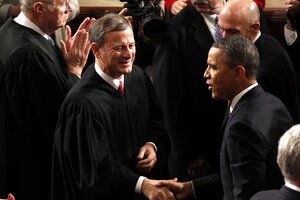Obama, like Roberts, seeks harmony in Washington
President Obama cites the military as a model for politics, similar to the aim of Chief Justice John Roberts for consensus on the Supreme Court. Why are both goals not working?

Supreme Court Chief Justice John Roberts greets President Barack Obama on Capitol Hill Jan. 24, prior to the president's State of the Union address.
AP Photo/J. Scott Applewhite
Twice last week, President Obama held up the military as a model for American politics. In his State of the Union message and later in a radio broadcast, he commended the armed forces for not being consumed with personal ambition or obsessed over differences.
“They work together,” he stated.
His plea for similar harmony among elected leaders is an echo of one made in 2005 by John Roberts Jr. when he became the chief justice of the Supreme Court.
After being nominated, Mr. Roberts said he would try to create a more “collegial atmosphere” among the nine justices, take on fewer cases, and, most of all, seek greater consensus in rulings to avoid the 5-to-4 splits that hurt the court’s legitimacy.
He noted how the early years of the court in the 19th century saw most rulings made with a unanimous vote. Both Roberts, and a later justice, Sonia Sotomayor, also claimed they would try to be the kind of judges that act with neutrality, not ideology. (They may have had in mind the court’s 2001 split decision, Bush v. Gore, that helped decide a presidential election.)
Both the president and the chief justice took over their jobs with the high hope of bringing a spirit of nonpartisanship to their Washington tenures. And they both cited models to follow – today’s military and the Supreme Court of two centuries ago, respectively.
Both leaders, however, have had only limited success in their goals. One reason may be that their suggestions for models are flawed.
The military, by definition, focuses on an enemy and relies on discipline and cohesion to defeat a foe (and minimize defections). It also receives its marching orders from elsewhere, a civilian leadership.
Elected leaders, on the other hand, receive their signals from a divided and diverse public of 300 million. These leaders are expected to work out differing ideologies and interests by compromise and voting. If they don’t, another election may help sort it out for them. Or the nation’s problems are thrown to other levels of government, such as states, or left to the private sector.
The commander in chief may enjoy the practical and quick results of, say, a raid on Osama bin Laden. But he should not expect Congress to march to his orders in a similar fashion.
Roberts, too, confuses today’s America with the early Republic. Back then, much less was expected of government, and hot-button social issues were fewer. And Americans had not yet learned they could run to the courts to win victories that they couldn’t win in elections or in Congress.
At best, Roberts and Obama can ask their fellow leaders to act out of principle and integrity, as they see it, while always looking for common goals that can be achieved with little dissension. In both the courts and Congress, leaders are expected to exercise judgment in the face of difficult facts or unclear legal precedents.
To his credit, Roberts has tried to limit the scope of Supreme Court decisions with narrow rulings. Making broad declarations can only divide the court – and the public. Obama, too, has often compromised on political issues rather than draw a firm line in the sand. But both seem frustrated in their goals.
Small steps can unite better than big leaps. The Constitution is designed to prevent quick decisions. America is not a command society, as is the military, and the three branches provide a balance to competing visions.
Both the justices and lawmakers must practice the kind of collegiality and civility that lubricate effective decisionmaking. Pointing to a past time or the military model can only divert attention from the hard work of governance.

